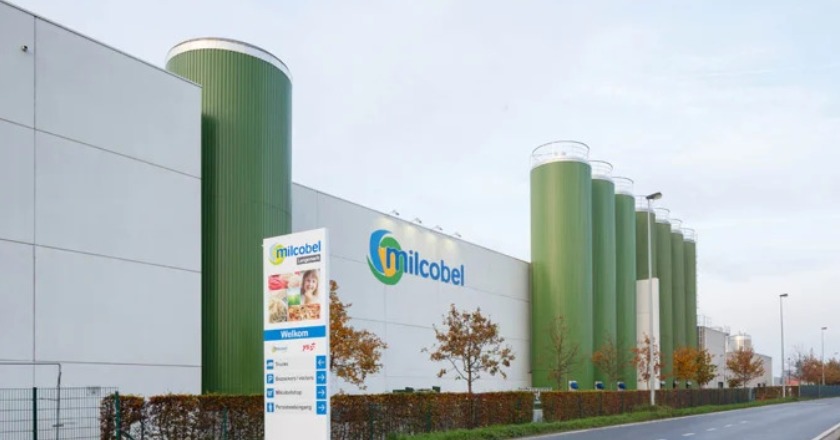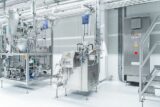On Thursday the 11th of May, Milcobel’s Mozzarella Experience Center was officially inaugurated in the presence of MEP Tom Vandenkendelaere. In this experience centre Milcobel wants to use its years of expertise for the benefit of professional customers from all over the world.
“Over the past 20 years, Milcobel has invested in research into the characteristics of mozzarella as an ingredient, and this thanks to long-term cooperation with universities and research institutes in Belgium and beyond,” states Francis Relaes, managing director of Milcobel Premium Ingredients. “This resulted in valuable insights and knowledge about the behaviour of mozzarella in a whole range of applications. But it also taught us more about ripening, transport, freezing, thawing and other important issues in the many export markets where Milcobel operates.”
It is that knowledge and insight, among others, that Milcobel now wants to share more intensively with customers and partners. The traditional sales relationship will be broadened to include R&D, marketing, etc. Demos will take place in the Mozzarella Experience Center, for example, where specific applications for customers can be tested and analysed. Innovation and inspiration days will be organised for professional customers, and Milcobel will set up collaborations with pizza chefs, chefs and hotel schools as well.
Knowledge hub for mozzarella
In the coming years, the Milcobel site in Langemark will become a knowledge hub for mozzarella and pasta filata cheeses and their applications. Mozzarella is a technically very complex product. Customers set specific criteria when preparing the cheese, in terms of colour, blistering (how the cheese bakes out), oil off (smoothness), and the way the cheese melts and stretches. Building up this expertise takes many years, and it is thanks to the experience of the past 28 years that Milcobel has worked its way up to become one of the reference companies in Europe and beyond.
“With the opening of the Mozzarella Experience Center, we are taking the next step in our mozzarella story,” says Francis Relaes. “Here we continue to build a sustainable future for our cooperative and our company by focusing on innovation, know-how, co-creation and collaboration with customers and chefs worldwide. A true experience centre where we put our knowledge and expertise at the service of our customers.”
“Milcobel has succeeded in putting Belgium on the map as a mozzarella country,” says MEP Tom Vandenkendelaere, who officially inaugurated the Mozzarella Experience Center. “Anno 2023, Milcobel not only has the reputation of pioneering Belgian mozzarella at home, but its fame reaches far beyond its own borders in Europe. The ingredients at the basis of this success story – embedding sustainability in the economic and social fabric of the region – are also at the basis of what we want to achieve Europe-wide with the Green Deal. That also includes making our food policy more sustainable with the ‘farm-to-table’ strategy. Milcobel is committed to economic and social sustainability and invests in sustainable production processes. Cooperative companies like Milcobel also play an important role in European policy precisely because they strengthen the farmer. This is therefore both the ambition and the challenge for Milcobel. We need more awareness and respect for sustainable and high-quality production in our region. Because it is precisely this expertise, knowledge and quality that has put our region on the map,” says Vandenkendelaere.
Mozzarella gains popularity in Asia
“We have customers in 80 countries worldwide. Historically, we have a strong presence in Europe, mainly southern Europe (Spain, Italy and Portugal) and the UK. This European market has an annual growth rate of around 3%. In recent years, we have seen that the Asian market in particular has become more important. In several Asian countries, we see above-average growth of 6-7% per year,” states Francis Relaes. “The establishment of Milcobel Asia with an office in Hong Kong some five years ago has brought strong volume growth for Milcobel in the region and gives us particular insight into developments in these markets. Milcobel was also able to benefit from the free trade agreements concluded in recent years with countries such as South Korea and Japan.”
In Europe, mozzarella is mainly used for pizzas. However, the most innovative mozzarella recipes you see today are located in Asia, both in the sophisticated fusion kitchen but also in challenging street food dishes such as squid with mozzarella, corn dogs with cheese, or plantain with sprinkles and mozzarella… Asians are especially fond of the ‘fun factor’ mozzarella offers. The days when Asians did not eat cheese thus seem to be over. Some of these tendencies also make it to Europe.
Not just mozzarella
The mozzarella produced by Milcobel in Langemark is not the balls of mozzarella you typically buy in the supermarket as a consumer. Milcobel produces mozzarella as an ingredient for the food service market, these are producers of pizza, pasta, paninis or other dishes, or restaurant chains.
Mozzarella is the most popular cheese in the world at the moment. It originated in Italy and was initially produced from the milk of water buffaloes. Later, people started producing mozzarella from cow’s milk, all over the world. However, the group of ‘formaggi a pasta filata’ – or ‘skirted cheese’ consists of a wide range of cheeses from the fresh soft mozzarella balls (made mainly in Italy) to the ‘low moisture’ mozzarella blocks produced by Milcobel in Langemark. This type of mozzarella represents 88% of the approximately 3.8 million tonnes of mozzarella produced worldwide. About 2.3 million tonnes of this is produced in the US, primarily destined for the home market, and only a small percentage of US production is destined for export.
In Europe, Italy and Germany are the largest consumers of mozzarella (mozzarella balls and low moisture mozzarella combined), but not the largest producers.
More than 25 years of experience
Milcobel’s cheese history begins as early as 1964 with cheddar production in Wingene. In 1995, the group’s ingredient cheese production was centralised in Langemark, where 65,000 tonnes of mozzarella now rolls off the production lines every year. The company’s ambition is to grow even further in the coming years in mozzarella.



